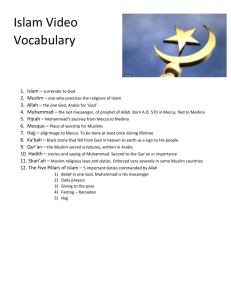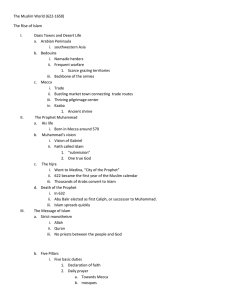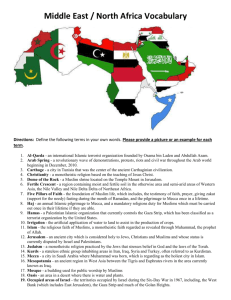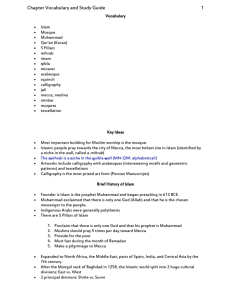Beginnings of Islam - Cherokee County Schools
advertisement
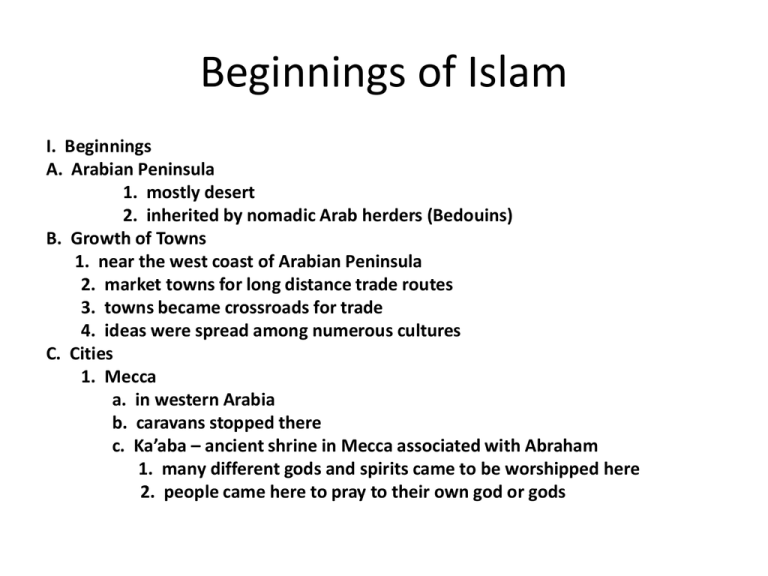
Beginnings of Islam I. Beginnings A. Arabian Peninsula 1. mostly desert 2. inherited by nomadic Arab herders (Bedouins) B. Growth of Towns 1. near the west coast of Arabian Peninsula 2. market towns for long distance trade routes 3. towns became crossroads for trade 4. ideas were spread among numerous cultures C. Cities 1. Mecca a. in western Arabia b. caravans stopped there c. Ka’aba – ancient shrine in Mecca associated with Abraham 1. many different gods and spirits came to be worshipped here 2. people came here to pray to their own god or gods Muhammad 1. 2. 3. 4. 5. 6. born in city of Mecca was orphaned at age of 6 had very little schooling became a trader and businessman eventually married his boss age 40 – while meditating in a cave, he heard the voice of Gabriel tell him to spread the word of Allah 7. was convinced he was the last and most important prophet of God The Hijrah – “The Migration” The Hijrah – “The Migration” 1. Muhammad began to preach publicly in Mecca by 613 AD 2. his messages were met with some opposition 3. Muhammad and supporters fled to small town of Yathrib 4. while in Yathrib, Muhammad preaches and gains many followers 5. Muhammad learned to be a military and political leader here Return To Mecca 1. 630 AD – Muhammad and 10,000 followers return to Mecca 2. Leaders of Mecca surrender the city to Muhammad 3. Muhammad destroys the idols at the Ka’aba 4. most Meccans will convert to Islam Death of Muhammad 1. 632 AD – Muhammad is dead at age 62 2. his followers write his teachings and revelations in a book, called the Qu’ran 3. it will be used as the holy book of Islam 4. only the Arabic version of the Qu’ran is considered the true word of God Islamic Beliefs • • • • • • • • Islam – submission to the will of Allah Koran – Muslim Holy Book Mosque- religious temple Sharia- Muslim law code Like Christianity and Judaism it is monotheistic Also concerned with salvation and after-life No claim to divinity of Muhammed Muhammed was the last prophet. Do believe in Old Testament • All 3 see Jerusalem as a Holy City Dome of the Rock - Jerusalem Koran – Islamic Holy Book Five Pillars of Islam • • • • • Belief in Allah and Muhammed is his prophet Pray five times a day facing Mecca Observe holy month of Ramadan Make a Pilgrimage to Mecca Give alms to the poor Muhammad’s Successors Muhammad’s Successors – Capital is Mecca 1. called caliphs 2. believe in the shari’a (system of law) 3. will be known as the “Rightly Guided Caliphs” because they follow the Sunna 4. Sunna – the example of Muhammad 5. Abu Bakr – first successor; he used jihad (holy war) to expand Islam a. established a Muslim empire that covered all of Arabia b. died in 634 AD 6. Umar – second caliph – use jihad a. conquers Syria, lower Egypt, and parts of Sassanid (Persian) Empire Internal Conflict Creates Crisies Search for New Caliph 1. 656 AD – caliph Uthman dies – civil war erupts between various Muslim groups 2. Ali is blood descendant of Muhammad – and natural successor to empire 3. 661 – Ali is assassinated – no way for next caliph to be elect Rise of Umayyads Caliphate • Move capital to Damascus • Abandoned simple life of previous caliphs and surround themselves with wealth • Expanded from Persia into Central Asia • Expanded to North Africa through Spain and into France • Stopped in France at the battle of Poitiers or Tours • Tried to take Constantinople but were defeated by Greek Fire • Decadent behavior leads to their demise and overthrow Battle of Tours Importance of Battle • Frankish infantry held back Muslim cavalry • Saved Christian Europe from Islamic invaders • Increased the power of the Frankish empire • Christians will begin to reconquer Spain, known as the reconquista Charles Martel Sunni vs. Shite 1. Sunni – believe rulers should follow example of Muhammad 2. Shi’a – believe rulers should be descendants of Muhammad Abassids and Islamic Golden Age 1. rebelled against the Umayyads – led to their downfall 2. officially came to power in 750 AD – after assassinating all Umayyad family members 3. move the capital of the empire to Bagdad in 762 AD a. led to increased trade and wealth for the empire Golden Age • Occurred under Harun al-Rashid • Economic Prosperity • Baghdad becomes center of huge commercial market because of its location • Advances in learning Connections 1. All Muslims were connected through religion, language, currency, and trade 2. massive cities were built throughout the empire as trade centers 3. many advances were made by the Muslim people in technology, math, and art 4. example: city of Cordoba had a population of 200,000 while Paris had a population of 38,000 Calligraphy • The art of beautiful handwriting Astrolabe • Typical uses of the astrolabe include finding the time during the day or night, finding the time of a celestial event such as sunrise or sunset and as a handy reference of celestial positions. Ibn Sina • The Canon of Medicine, which was a standard medical text in Europe and the Islamic world up until the 18th century • The book is known for the discovery of contagious diseases and sexually transmitted diseases, the introduction of quarantine to limit the spread of infectious diseases, the introduction of experimental medicine, clinical trials, neuropsychiatry, risk factor analysis, and the idea of a syndrome in the diagnosis of specific diseases Medicine – Al Razi • Wrote Treatise on Smallpox and Measles • Believed patients would recover more quickly if they breathed cleaner air Math – Al Khwarizmi • Wrote a textbook in the 800s explaining “the art of brining together unknowns to match a know quantity” • Called this technique Al-jabr – today called algebra Literature – Thousand and One Nights Ibn Rushd (1126-1198) • Argued that Greek philosophy and Islam both had the same goal: to find the truth • Was stoned in Great Mosque of Cordoba for views • Renowned by European scholars Ibn Battuta (1304-1369) • Wrote book Rihla about his travels, compare to Marco Polo • Traveled for over 30 years • covered almost the entirety of the known Islamic world and beyond, extending from North Africa, West Africa, Southern Europe and Eastern Europe in the West, to the Middle East, Indian subcontinent, Central Asia, Southeast Asia and China in the East Reasons for Decline of Abassids • Dispute over succession within caliphate • Vast wealth contributed to financial corruption • Move away from the strict moral Islamic code • Foreign invasions on the borders, specifically from the Seljuk Turks Seljuk Turks • Nomads from Central Asia that conquered Abassids and Baghdad • Turks conquer most of Anatolia in 1071 by defeating the Byzantines • Ruler was called a Sultan • Turks ended the squabble between the Sunni and Shi’ites Crusades • Christian attacks into Islamic lands in order to regain Jerusalem and protect Christian shrines • Crusades helped to unite Islam against foreign invaders • Created hatred and distrust between Christians and Muslims • Forced Europe to find new sea routes to India and China because land routes went through the hostile middle east. Mongol Influence on Muslim World • Were not Muslim • Treated territory horrible • Mongols settled down in territory eventually converting to Islam and inter-marrying with the Arab population • Soon there was no distinction • New capital is Cairo and a renaissance in Muslim culture took place

